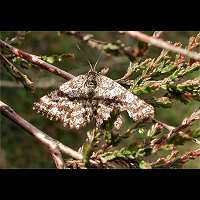Common Heath (Ematurga atomaria)
The Common Heath is not the easiest species to identify. Often it has darkbrown bands running on a whitish undergound. The bands however often turn into blurs or just dots. The ground colour may also be yellowish or even brownish. Sometimes completely umarked brown animals are observed. These look like some brownish skippers a lot, for the Common Heath flies during the day. It is however easy to tell the difference. Skippers, being butterflies, have long, threadlike antennae with a knob on the end. The Common Heath has big feathery antennae. Usually you won't have much difficulty identifying the Common Heath though, for there are few moths flying on heath during broad daylight. Reaching a wingspan of 24 to 34 mm, this is a rather small Geometer.
The eggs hatch in July and may be found on the foodplants to September. Then they drop to the ground and pupate underground. They overwinter as a pupa. The caterpillars of the Common Heath are extremely variable. They may be yellowish, greenish, brownish or even almost blackish. Sometimes there are white dots and lines on the back. The head usually is greenish, but sometimes brownish and has dark brown markings. The larvae will reach a length of some 30 mm. Usually found on heathers and heath, this species also lives in light forests and grasslands. In the latter the larvae feed on clovers.
Mainly double-brooded, the Common Heath is on the wing from May to August. Most numerous by the end of May and the beginning of June and again in the beginning of August. In northern parts of Britain single-brooded normally flying in June and July. Flies by day, especially on hot and sunny days. A very common species all over Britain and also on the continent, except for areas with a rich soil.
The Common Heath is not the easiest species to identify. Often it has darkbrown bands running on a whitish undergound. The bands however often turn into blurs or just dots. The ground colour may also be yellowish or even brownish. Sometimes completely umarked brown animals are observed. These look like some brownish skippers a lot, for the Common Heath flies during the day. It is however easy to tell the difference. Skippers, being butterflies, have long, threadlike antennae with a knob on the end. The Common Heath has big feathery antennae. Usually you won't have much difficulty identifying the Common Heath though, for there are few moths flying on heath during broad daylight. Reaching a wingspan of 24 to 34 mm, this is a rather small Geometer.
The eggs hatch in July and may be found on the foodplants to September. Then they drop to the ground and pupate underground. They overwinter as a pupa. The caterpillars of the Common Heath are extremely variable. They may be yellowish, greenish, brownish or even almost blackish. Sometimes there are white dots and lines on the back. The head usually is greenish, but sometimes brownish and has dark brown markings. The larvae will reach a length of some 30 mm. Usually found on heathers and heath, this species also lives in light forests and grasslands. In the latter the larvae feed on clovers.
Mainly double-brooded, the Common Heath is on the wing from May to August. Most numerous by the end of May and the beginning of June and again in the beginning of August. In northern parts of Britain single-brooded normally flying in June and July. Flies by day, especially on hot and sunny days. A very common species all over Britain and also on the continent, except for areas with a rich soil.





